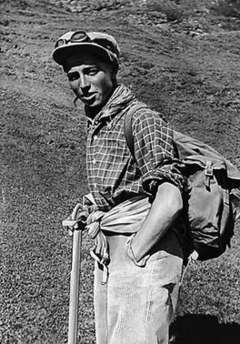Andreas Hinterstoisser
Andreas Hinterstoisser (3 October 1914 – 21 July 1936[1]) was a German mountain climber active in the 1930s. He died during an attempt to climb the Eiger north face with his partner Toni Kurz. A section of the north face was later named the "Hinterstoisser Traverse" in his honor. The 2008 film North Face was based on his experience climbing the Eiger.
 Andreas Hinterstoisser, 1936 | |
| Personal information | |
|---|---|
| Nationality | German |
| Born | 3 October 1914 Bad Reichenhall, Bavaria, Germany |
| Died | 21 July 1936 (aged 21) Eiger |
| Climbing career | |
| Named routes | Hinterstoisser Traverse |
Biography
Andreas Hinterstoisser was born on 3 October 1914 in Bad Reichenhall, Bavaria, Germany, where he was raised. He worked in a bank before joining the German Wehrmacht as a professional soldier in 1935. Together with his childhood friend Toni Kurz, he made numerous first ascents of peaks in the Berchtesgaden Alps, including some of the most difficult climbs of that time. The two young men climbed the southwest wall of the Berchtesgadener Hochthron in 1934, and the south wall of the straight pillar in 1936. They also made first ascents in the Reiter Alpe on the German–Austrian border, and of the direct southern route up the Watzmannkinder in the Watzmann in 1935.[2]
In 1936 he formed part of a four-man team making the second attempt to scale the north face of the Eiger. He was renowned as one of the best rock climbers of his time and is held in high esteem to this day. He cleverly traversed a slab of icy rock, a feat which made the rest of the attempt on the Eiger possible, by climbing up on it and lowering himself to execute a pendulum to the other side, securing a rope and enabling his companions to cross the impassable section. This move became known as the Hinterstoisser Traverse.[3]

During a retreat from the wall, due both to an injury suffered by one of his comrades and to the severe weather, Hinterstoisser could not recross the traverse to safety because the group had previously removed the rope that had helped them across. The group decided to abseil down the vertical face (the great rock barrier) to the base of the mountain.[3] Contact was made with a railway guard halfway down the descent during which the climbers called back that everything was all right (perhaps from pride and the knowledge that they were close to safety). However, as Hinterstoisser set up the last stage of the descent an avalanche came down the mountain, wiping out Hinterstoisser, who had unclipped from the group. He fell to his death and was found at the bottom of the mountain days later. The rest of the group suffered the same fate: Willy Angerer was killed by the impact; Edi Rainer was asphyxiated from the weight of the rope holding his comrades; and Toni Kurz died from exposure, despite having made contact with rescuers.[4]
Legacy
The tragic story became well known after publication of Heinrich Harrer's classic 1960 book The White Spider and was more recently covered by Joe Simpson's book (and Emmy-winning TV documentary), The Beckoning Silence, as well as the 2008 German dramatic movie North Face.[5]
References
Citations
- Harrer 1998, pp. 41–42.
- Auffermann 2010, p. 91.
- Gilbert, Dave (3 September 2001). "Eiger's grim reputation". BBC News. Archived from the original on 4 February 2008. Retrieved 23 December 2007.
- "The Hinterstoisser Traverse". The North Face of the Eiger. Mountain Zone. Archived from the original on 2 December 2008. Retrieved 14 November 2008.
- Cooper, Kate (May 2008). "The Eiger Nordwand Revealed: Rainer Rettner Interview". UK Climbing. Retrieved 8 January 2013.
Sources
- Anker, Daniel (ed.) (2000). Eiger: The Vertical Arena. Seattle: The Mountaineers Books. ISBN 978-0898866797.CS1 maint: extra text: authors list (link)
- Auffermann, Uli (2010). Entscheidung in der Wand: Marksteine des Alpinismus. Schall-Verlag. ISBN 978-3900533625.
- Fleming, Fergus (2002). Killing Dragons: The Conquest of the Alps. New York: Atlantic Monthly Press. ISBN 978-0802138675.
- Harrer, Heinrich (1998) [1959]. The White Spider. New York: Tarcher. ISBN 978-0874779400.
- Heckmair, Anderl (2002). My Life. Seattle: The Mountaineers Books. ISBN 978-0898868463.
- Simpson, Joe (2002). The Beckoning Silence. New York: Jonathan Cape. ISBN 978-0224061803.
External links
- Rote Fluh and Hinterstoisser Traverse Eiger north face photos - Wayback Machine archive